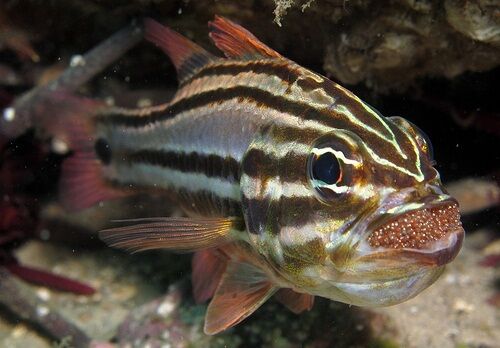Fertilization is the union of a male gamete and a female gamete.
In all animals, sexual reproduction occurs through the interaction of a male individual and a female individual, a process known as mating. During mating, fertilization can take place, depending on the species, inside (internal fertilization) or outside (external fertilization) of the mate's body, most often the female’s.
External fertilization usually occurs in water, where eggs are released by the female so that they can be fertilized by the male later.
No physical contact between the two partners is then necessary. Depending on the species, eggs can be released anywhere in the environment. They can also be laid in a nest or a previously arranged support area. Sometimes, eggs being buried in the sediment can also be observed. Finally, some species may keep the eggs in their mouth (male or female) and even in a ventral pouch (like the male in seahorses), all in order to protect the eggs.

Unlike the zygotes generated by internal fertilization, which are few in number, those which come from external fertilization are many. However, many fertilized eggs will not reach full term if not given any protection.
Internal fertilization takes place directly in the female's body. A male anatomical structure is therefore necessary for the gametes to meet.
This fertilization is possible via a male anatomical structure called cloaca in reptiles, birds, amphibians, and fish, whereas in mammals it is called a penis. This male anatomical structure allows the sperm containing the male gametes to be deposited in the female reproductive system and to encounter a female gamete in the female’s body. For this type of fertilization to take place, physical contact between the two mates must occur.
Internal fertilization results in fewer zygotes than in the case of external fertilization. However, the resulting zygotes have a better chance of survival since they are protected by the female's reproductive system, for example the uterus, where they develop.
The onset of menstruation in a girl is an indicator of her ability to be fertilized by a male sex cell (a spermatozoon). Indeed, a woman who menstruates means that in each menstrual cycle an ovum is expelled from one of her ovaries (there may exceptionally be more than one ovum released during a cycle). This is the ovulation period, which corresponds to a period of fertility in women. If the egg is not fertilized by a spermatozoon, then a woman’s period will start about 14 days after ovulation.
If unprotected sexual intercourse between a man and a woman occurs during the woman's fertile period, it can result in fertilization, that is, the union of an ovum and a spermatozoon, which results in pregnancy. This is why it is important to use effective means of contraception if pregnancy is not intended. Some of these are also useful as they provide protection against sexually transmitted infections and blood-borne infections (STIs and BBIs). Be careful, though, as not all means of contraception are useful for protecting against STBBIs; the birth-control pill is an excellent example of a contraceptive method that does not protect against STBBIs.
During a woman's fertile period (which corresponds to the ovulation stage of her menstrual cycle), the penetration of the man's penis into the vagina, followed by ejaculation, will allow the spermatozoa contained in the semen to encounter the single ovum released when the woman ovulates.
-
The woman's sex cell (gamete) is called an ovum.
-
The male's sex cell (gamete) is called a spermtozoon.
-
The vagina is a woman's reproductive organ. It is actually an internal organ that collects a man's sperm during intercourse.
-
The penis is the male reproductive organ. This is an organ that allows spermtozoa to enter a woman's vagina during sexual intercourse.
Here are some interesting facts.
-
At the time of ejaculation, between 3 and 5 mL of semen is released. Each millilitre of semen contains between 50 and 100 million spermatozoa. Only one sperm is needed to fertilize an ovum.
-
Spermatozoa can survive for 24 to 72 hours in a woman's reproductive system.
-
The ovum survives 2 days waiting to be fertilized.
-
Fertilization takes place in the fallopian tube.
-
The result of the spermatozoon and ovum encounter is the formation of a zygote, which will then nest in the uterus to develop into an embryo, and then into a fetus.
For more information on embryonic development, refer to the concept sheet on the stages of human development